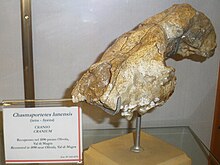
Summary
Chasmaporthetes, also known as hunting or running hyena, is an extinct genus of hyenas[1][2][3][4] distributed in Eurasia, North America, and Africa during the Pliocene-Pleistocene epochs, living from 4.9 million to 780,000 years ago, existing for about 4.12 million years.[5] The genus probably arose from Eurasian Miocene hyenas such as Thalassictis or Lycyaena, with C. borissiaki being the oldest known representative.[6] The species C. ossifragus was the only hyena to cross the Bering land bridge into the Americas, and ranged over what is now Arizona and Mexico during Blancan and early Irvingtonian Land Mammal ages, between 5.0 and 1.5 million years ago.[6][4]
| Chasmaporthetes Temporal range:
| |
|---|---|

| |
| C. lunensis skull | |
| Scientific classification | |
| Domain: | Eukaryota |
| Kingdom: | Animalia |
| Phylum: | Chordata |
| Class: | Mammalia |
| Order: | Carnivora |
| Suborder: | Feliformia |
| Family: | Hyaenidae |
| Subfamily: | Hyaeninae |
| Genus: | †Chasmaporthetes Hay, 1921 |
| Species | |
|
See text | |
| Synonyms | |
|
Euryboas | |
Chasmaporthetes was one of the so-called "dog-like" hyenas (of which the aardwolf is the only survivor), a hyaenid group which, in contrast to the now more common "bone-crushing" hyenas, evolved into slender-limbed, cursorial hunters like modern canids.[4]
Taxonomy and etymology edit
Chasmaporthetes was named (from chasm and the Greek πορθευτής (portheutes), "destroyer, ravager") by Hay (1921), who noted that the name meant that the North American species, Chasmaporthetes ossifragus (the type species) possibly saw the beginning of the Grand Canyon.
Species edit
At least nine species are currently recognised:[7][8]
- Chasmaporthetes ossifragus Hay, 1921 - North America, Pliocene to Pleistocene
- C. australis Hendey, 1974 - Africa, Late Miocene
- C. bonisi Koufos, 1987 - Greece, Late Miocene
- C. borissiaki Khomenko, 1932 - Russia, Pliocene (disputed[9])
- C. exitelus Kurtén & Werdelin, 1988 - China, Late Miocene
- C. gangsriensis Tseng, Li, & Wang, 2013 - Asia, Early Pliocene[7]
- C. lunensis Del Campana, 1914 - Eurasia, Late Miocene to Early Pleistocene
- C. melei Rook et al, 2004 - Sardinia, Early Pleistocene[9]
- C. nitidula Geraads, 1997 - Africa, Pliocene to Early Pleistocene
Anatomy and paleoecology edit
The limb bones of Chasmaporthetes were long and slender like those of cheetahs, and its cheek teeth were slender and sharp-edged like those of a cat. Chasmaporthetes likely inhabited open ground and was a daytime hunter. In Europe, the species C. lunensis competed with the giant cheetah Acinonyx pardinensis, and may have preyed on the small Bourbon gazelle (Gazella borbonica) and the chamois antelope (Procamptoceras brivatense).[10] The North American C. ossifragus was similar in build to C. lunensis, but had slightly more robust jaws and teeth. It may have preyed on the giant marmot Paenemarmota,[6] and competed with the far more numerous Borophagus diversidens.[11] A study on the genus' premolar intercuspid notches indicated Chasmaporthetes was likely hypercarnivorous rather than durophagous as its modern cousins (excluding the aardwolf) are.[12]
References edit
- ^ O. P. Hay. 1921. Descriptions of species of Pleistocene Vertebrata, types or specimens of most of which are preserved in the United States National Museum. Proceedings of the United States National Museum 59:599-642
- ^ D. Geraads. 1997. Carnivores du Pliocene terminal de Ahl al Oughlam (Casablanca, Maroc). Géobios 30(1):127-164
- ^ J. J. Flynn. 1998. Early Cenozoic Carnivora ("Miacoidea"). In C. M. Janis, K. M. Scott, and L. L. Jacobs (eds.), Evolution of Tertiary Mammals of North America 1:110-123
- ^ a b c Macdonald, David (1992) The Velvet Claw: A Natural History of the Carnivores, p. 119-144, New York: Parkwest, ISBN 0-563-20844-9
- ^ PaleoBiology Database: Chasmaporthetes, basic info
- ^ a b c Kurtén, Björn (1980) Pleistocene mammals of North America, p. 199, Columbia University Press, 1980, ISBN 0-231-03733-3
- ^ a b Tseng, Z.J.; et al. (2013). "A new cursorial hyena from Tibet, and analysis of biostratigraphy, paleozoogeography, and dental morphology of Chasmaporthetes (Carnivora, Mammalia)". Journal of Vertebrate Paleontology. 33 (6): 1457–1471. doi:10.1080/02724634.2013.775142. S2CID 131282725.
- ^ Pérez-Claros, J.A.; Coca-Ortega, C.; Werdelin, L. (May 2021). "How many hyenas in North America? A quantitative perspective". Journal of Vertebrate Paleontology. 41 (3): e1979988. doi:10.1080/02724634.2021.1979988. S2CID 244614066.
- ^ a b Rook, L.; Ferretti, M.P.; et al. (2004). "Chasmaporthetes melei n. sp. an endemic hyaenid (Carnivora, Mammalia) from the Monte Tuttavista fissure fillings (Late Pliocene to Early Pleistocene; Sardinia, Italy)". 110: 707–714. Retrieved 13 March 2022.
{{cite journal}}: Cite journal requires|journal=(help) - ^ Kurtén, Björn (1968) Pleistocene mammals of Europe, p. 68-69, Weidenfeld and Nicolson, 1968
- ^ Wang, Xiaoming & Tedford, Richard H. (2008) Dogs: their fossil relatives and evolutionary history Columbia University Press, ISBN 0-231-13528-9
- ^ A. Hartstone-Rose (2011) Reconstructing the diets of extinct South African carnivorans from premolar ‘intercuspid notch’ morphology, Journal of Zoology, Vol. 284 Issue 2
External links edit
- Anton, M., Turner, A., Salesa, M. J., Morales, J. A complete skull of Chasmaporthetes lunensis (Carnivora, Hyaenidae) from the Spanish Pliocene site of La Puebla de Valverde (Teruel) Estudios Geol., Vol. 62, n.º 1, 375-388, enero-diciembre 2006. ISSN 0367-0449


